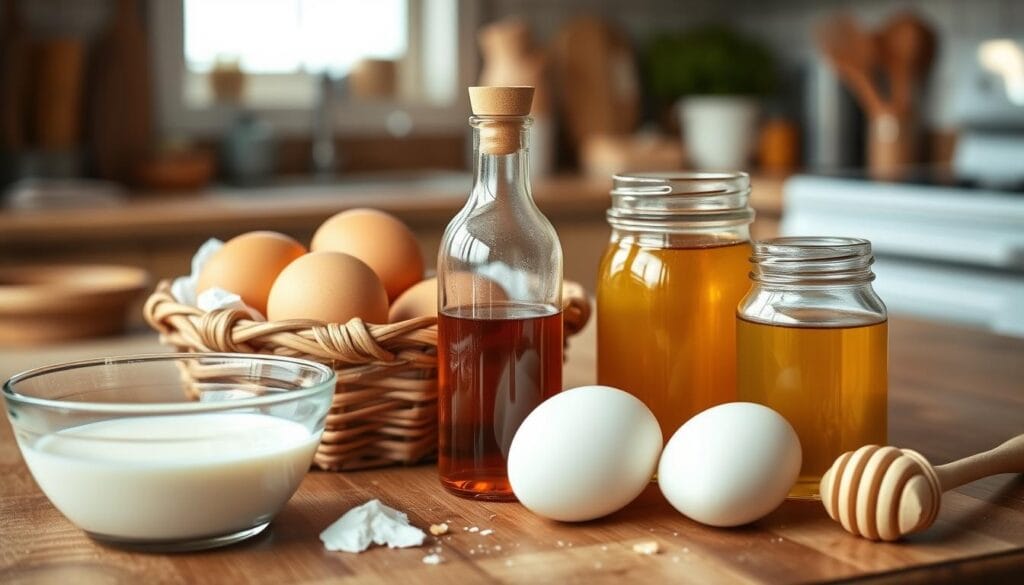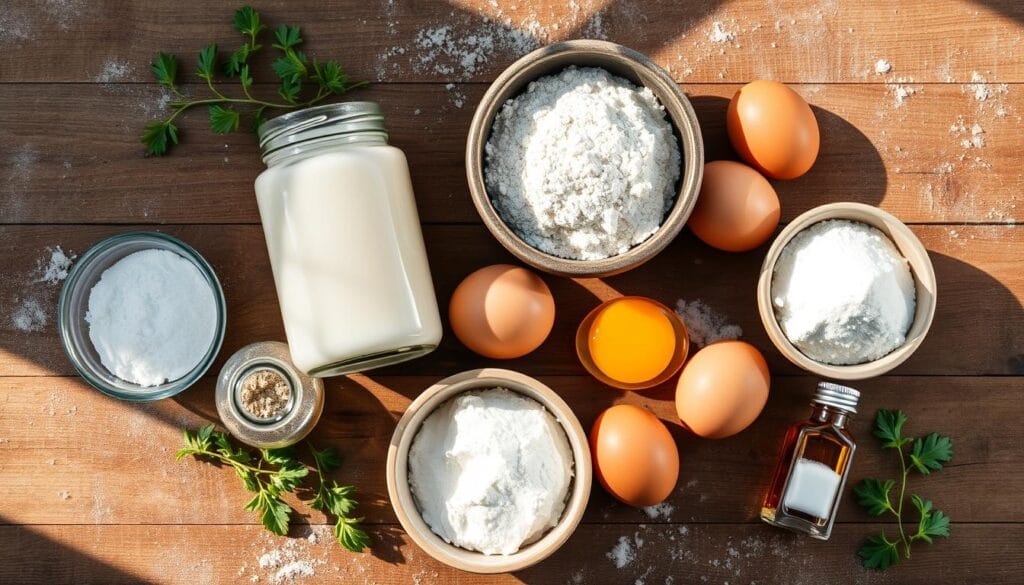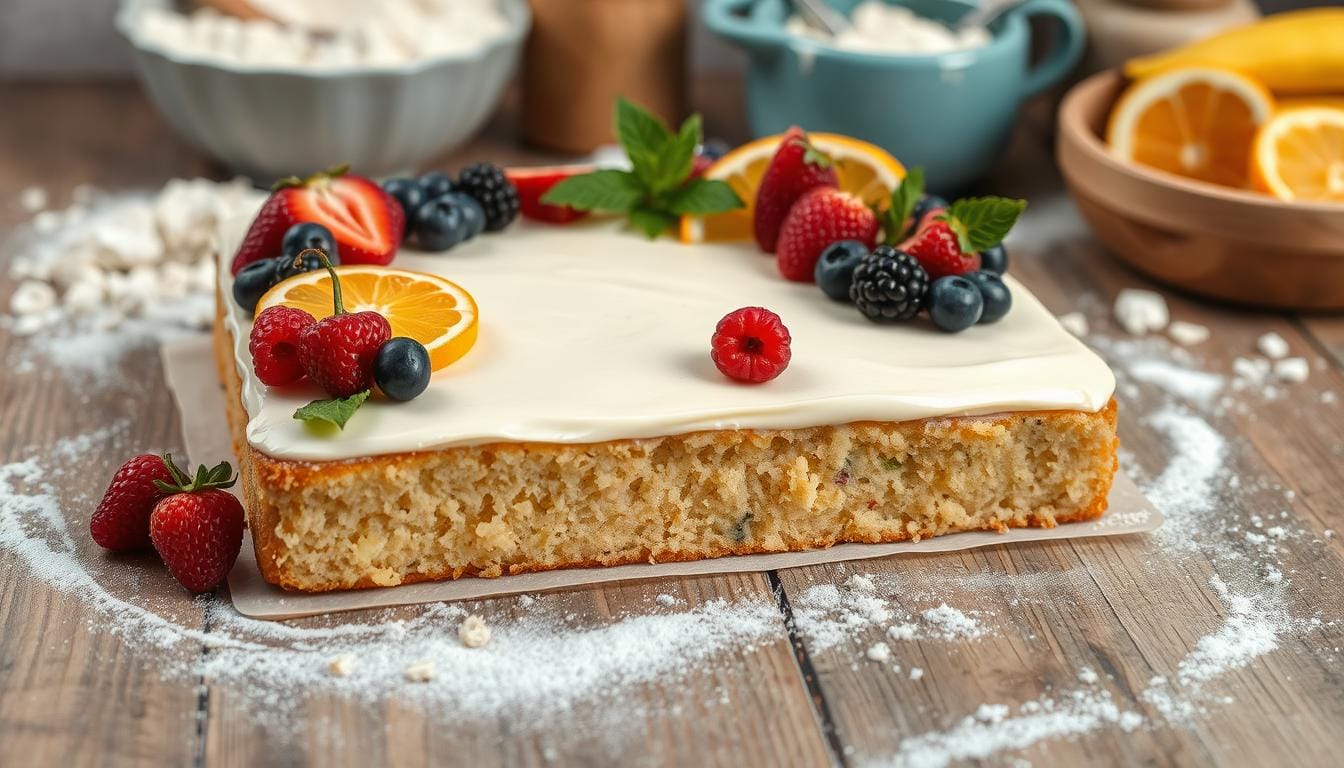Best Kefir Sheet Cake Ingredients for Home Baking
Kefir sheet cake ingredients is a delightful dessert that’s easy to make and full of flavor. It has a light, fluffy texture and a subtle tang. This makes it perfect for any occasion, whether you dress it up or keep it simple.
The recipe only needs ingredients you likely have at home. This makes it great for both experienced bakers and those just starting out.
Table of Contents
Key Takeaways
- Kefir is the hero ingredient that adds moisture, tanginess, and probiotic benefits to sheet cakes.
- The recipe uses common dry ingredients like flour, baking powder, baking soda, and sugar.
- Wet ingredients such as kefir, eggs, butter or oil, and vanilla extract create the perfect batter consistency.
- Proper temperature control and baking time are crucial for achieving the ideal crumb structure.
- Kefir sheet cakes can be customized with seasonal fruits and complementary flavors.
Understanding Kefir’s Role in Sheet Cake Baking
Kefir comes from Eastern Europe and Western Asia. It’s a fermented dairy product. It’s great for baking sheet cakes because of its unique qualities.
Properties That Make Kefir Perfect for Baking
Kefir adds a tangy flavor and creamy texture to cakes. It’s also full of probiotics. This makes it a healthier choice than heavy creams or buttermilk.
Health Benefits of Baking with Kefir
Using kefir in sheet cakes boosts flavor and nutrition. It’s packed with calcium, protein, and B vitamins. This makes your cakes more nutritious.
How Kefir Affects Cake Texture
Kefir’s acidity works with baking soda to make cakes light and fluffy. The fermentation process also makes the gluten tender. This results in a moist, delicate crumb.
Knowing how kefir works can open up new possibilities in baking. It can make your sheet cakes more flavorful and nutritious. Adding kefir to your recipes can make your fermented milk desserts stand out. They’ll have tangy cake flavors that everyone will love.
Essential Equipment for Perfect Sheet Cake Results
To bake a delicious kefir sheet cake, you need the right tools. These tools help with even heating, easy cake removal, and the perfect texture. Having the right equipment is key to making a professional-quality cake.
- High-quality baking sheet or rimmed sheet pan: This ensures even heat distribution for consistent baking.
- Parchment paper or a nonstick baking mat: These make it easy to remove the cake without sticking.
- Stand mixer or hand mixer: These are important for mixing the kefir and other wet ingredients well.
- Reliable oven thermometer: Accurate oven temperature is crucial for perfectly baked kefir sheet cakes.
- Offset spatula: This tool helps with smooth frosting and decorating, making your cake look great.
With these tools, you can make moist, tasty, and beautiful kefir sheet cakes. Kefir adds health benefits and a unique flavor to your cakes. It makes your baking special.
“Baking with kefir is a game-changer for sheet cakes. The probiotics and natural tang it provides result in a moist, delicious crumb that’s hard to beat.”
Investing in the right equipment and using kefir can make your baking healthier and more indulgent. Discover how versatile kefir is and enhance your kefir sheet cake creations.
The Science Behind Kefir Sheet Cake Ingredients
Making the perfect kefir sheet cake is more than just following a recipe. It’s about knowing the science behind the ingredients. Kefir, a probiotic-rich dairy product, is key. It helps with the chemical reactions and physical processes during baking, making the cake moist and tender.
Chemical Reactions During Baking
The acidity in kefir works with baking soda to create carbon dioxide. This gas makes the cake light and fluffy. It also helps the batter rise and expand. Plus, the proteins in kefir coagulate with heat, making the cake’s crumb tender.
Temperature and Timing Considerations
Getting the temperature right is crucial for a well-baked kefir sheet cake. The recipe suggests baking at 350°F (175°C). The cake should bake for 25-30 minutes. This ensures it’s fully cooked and has the right texture.
Moisture Control Fundamentals
Keeping the right balance of wet and dry ingredients is essential. Kefir adds moisture, while eggs and melted butter or oil do too. Measuring and mixing carefully helps avoid a dense or dry crumb.
By grasping the science behind kefir sheet cake ingredients, you can achieve consistent and tasty results. You’ll get perfectly risen layers and a moist, flavorful crumb every time.
Selecting the Right Type of Kefir
Choosing the right kefir for your sheet cake is key. Traditional dairy-based kefir is common, but there’s more. Options like coconut, almond, or oat milk kefir are great for those with dietary needs.
The kefir you pick can change your cake’s taste and feel. Full-fat kefir makes it creamy, while lower-fat makes it lighter. Try different kefir flavors to find the best for your cake.
| Kefir Type | Texture | Flavor | Dietary Considerations |
|---|---|---|---|
| Traditional Dairy Kefir | Thick and Creamy | Tangy and Slightly Sour | Not suitable for lactose intolerance or vegan diets |
| Coconut Milk Kefir | Rich and Silky | Subtle Coconut Taste | Dairy-free, vegan |
| Almond Milk Kefir | Light and Airy | Delicate Almond Flavor | Dairy-free, vegan |
| Oat Milk Kefir | Creamy and Smooth | Mild Oat Taste | Dairy-free, vegan |
When baking with kefir, think about how each variety can improve your sheet cake. Try different fermented milk products to match your taste and dietary needs.
Core Dry Ingredients for Your Recipe
Baking the perfect kefir sheet cake starts with the right dry ingredients. You’ll need all-purpose flour, sugar, baking powder, baking soda, and salt. Each ingredient adds something special to make the cake moist, flavorful, and well-structured.
Flour Types and Their Effects
The flour you pick can change your cake’s texture. All-purpose flour is a good choice because it’s sturdy yet tender. Cake flour makes the cake lighter and more delicate, but you might need to adjust other ingredients.
Leavening Agents Guide
Baking powder and baking soda are key for the cake’s rise and aeration. Baking powder works twice, once when mixed and again in the oven. Baking soda reacts with kefir’s acidity to create bubbles, making the cake lighter.
Sugar Options and Measurements
Sugar is important for sweetness, a golden crust, and a tender crumb. You can use granulated or brown sugar, each adding a different flavor. Getting the sugar amount right is key to avoid a dense or flat cake.
Getting the balance of these dry ingredients right is crucial. It helps you make a kefir sheet cake that’s light, moist, and full of flavor. By understanding each ingredient’s role, you can create your own unique kefir sheet cake.
Essential Wet Ingredients Beyond Kefir
Kefir is the main ingredient that gives your sheet cake a tangy, probiotic-rich taste. But, other wet ingredients are also key to making the cake moist, tender, and flavorful. Eggs, butter or oil, and vanilla extract are all important for the perfect texture and taste.
Eggs help hold the cake together, adding structure and richness. Butter gives a rich, indulgent flavor. Oil keeps the cake moist. Vanilla extract adds depth and complexity, enhancing the aroma and taste.
The right mix of wet and dry ingredients is crucial for the perfect cake. Finding the right balance is essential to bring out the best in your kefir sheet cake recipe.
Egg Alternatives for Baking
- Flax or chia seeds: Mix 1 tablespoon of ground flax or chia seeds with 3 tablespoons of water to replace 1 egg.
- Applesauce: Use 1/4 cup of unsweetened applesauce to replace 1 egg.
- Mashed banana: Substitute 1/2 ripe banana for 1 egg.
- Commercial egg replacer: Follow the instructions on the package to replace eggs in your recipe.
Flavor Enhancers Beyond Vanilla
- Citrus zest: Add a teaspoon of fresh lemon, orange, or lime zest to brighten the cake’s flavor.
- Spices: Cinnamon, nutmeg, or cardamom can add warmth and depth to your kefir sheet cake.
- Extracts: Try almond, maple, or rum extract to complement the kefir’s tangy profile.
By carefully choosing and balancing the wet ingredients in your kefir sheet cake recipe, you can improve the cake moisture, egg alternatives, and flavor enhancers. This will help you create a truly exceptional homemade treat.

Flavor Enhancers and Optional Add-ins
Make your kefir sheet cake even better with natural flavor boosters and spices. Kefir’s tangy taste is a great base. Adding a few special ingredients can elevate it even more.
Natural Flavor Boosters
Adding citrus zest, like lemon or orange, can brighten your cake. These natural additives mix well with kefir’s creaminess.
Complementary Spices Selection
Spices like cinnamon, nutmeg, or cardamom add warmth and comfort. They balance kefir’s tanginess, making the cake cozy and inviting.
For extra texture and taste, try adding chopped nuts, dried fruits, or chocolate chips. These cake flavoring extras should be mixed in gently. This ensures they’re spread evenly in the cake.
Trying out different flavor combinations lets you make kefir sheet cakes that are truly yours. You can tailor them to your liking.
“The beauty of baking with kefir is the endless possibilities for flavor exploration. By incorporating natural ingredients and spices, you can craft a truly signature cake that delights the senses.”
Mastering the Perfect Batter Consistency
Getting the batter just right is key for a great kefir sheet cake. It should be smooth and easy to pour but not too thin. Begin by mixing the butter and sugar until it’s light and fluffy. Then, add the eggs one at a time gently.
Next, mix in the dry ingredients slowly, switching with the kefir to avoid mixing too much. The batter should be well mixed but not too stiff. This ensures the cake bakes evenly and has a soft texture.
Here are some tips to help you master the perfect kefir sheet cake batter:
- Cream the butter and sugar thoroughly until the mixture is light and fluffy, about 2-3 minutes.
- Add the eggs one at a time, beating well after each addition to incorporate them fully.
- Alternate adding the dry ingredients (flour, baking powder, baking soda, salt) and the kefir, mixing just until combined.
- Avoid overmixing the batter, as this can develop gluten and result in a tough, dense cake.
- The final batter should be smooth, pourable, and free of lumps.
By focusing on the right cake batter techniques and mixing methods, you can get the batter just right. This will help your kefir sheet cake turn out moist, tender, and full of flavor.
| Ingredient | Quantity |
|---|---|
| All-purpose Flour | 2 cups |
| Granulated Sugar | 1 1/2 cups |
| Unsalted Butter, softened | 1/2 cup |
| Eggs | 3 |
| Kefir | 1 cup |
| Baking Powder | 2 tsp |
| Baking Soda | 1 tsp |
| Salt | 1/2 tsp |
Professional Techniques for Moist Results
Getting the right mix of moisture and texture in kefir sheet cake is an art. Professional bakers have mastered it. They use special techniques to make their home-baked goods as good as those from a bakery.
Temperature Control Methods
Keeping the right temperature is key to keeping the cake moist. Bakers often use a lower oven temperature, about 325°F (165°C). This helps the cake rise evenly and get a better texture.
This slow heat also prevents the outside from getting too brown. It lets the inside cook well without drying out.
Mixing Techniques for Optimal Texture
How you mix the batter affects the cake’s texture. For butter-based cakes, creaming the butter and sugar together is best. It adds air and makes the cake tender and moist.
For oil-based cakes, mixing all ingredients at once works well. It also makes the cake moist and soft.
Brushing the cake with a kefir syrup after baking adds more moisture and flavor. This keeps your kefir sheet cake fresh and moist for days.
“The secret to a moist, tender kefir sheet cake lies in the precision of your baking techniques. With a little practice, you can master the art of creating bakery-worthy results at home.”

Using these professional baking tips and techniques can unlock kefir’s full potential in your sheet cakes. You’ll get moist, flavorful, and beautiful cakes that will wow your family and friends.
Storage and Shelf Life Guidelines
Keeping your kefir sheet cake fresh is key. After it cools, store it in an airtight container at room temperature for up to 3 days. For longer, refrigerate it for up to a week or freeze for up to 3 months. Wrap it tightly in plastic and foil to avoid freezer burn. Thaw a frozen cake in the fridge overnight.
These tips help keep your cake fresh:
- Use a plastic or glass storage container to keep it moist.
- Refrigerate it on the lower shelf to avoid temperature changes.
- Label the frozen cake with the date of freezing for tracking.
- Thaw frozen cakes in the fridge overnight for even thawing.
Follow these guidelines to keep your kefir sheet cake fresh, moist, and delicious for everyone to enjoy.
Seasonal Variations and Ingredient Substitutions
Baking the perfect kefir sheet cake is all about being flexible and creative. You can change your recipe with the seasons. In spring, try adding fresh strawberry or tart rhubarb to your mix. For fall, apple or pumpkin are great choices.
If you follow a special diet, you can still enjoy a kefir sheet cake. Swap all-purpose flour for gluten-free options. Use plant-based kefir for a dairy-free treat. Try honey or maple syrup instead of sugar to change the taste.
By using seasonal baking and ingredient alternatives, you can make unique kefir sheet cakes. They celebrate each season and meet different dietary adaptations. So, get creative and bake to your heart’s content!
“The true joy of baking is in the endless possibilities to explore and create.” – Julia Child
Conclusion: Creating Your Signature Kefir Sheet Cake
To make your own kefir sheet cake, mix the techniques, ingredients, and flavors from this guide. Try different add-ins, frostings, or glazes to make a unique recipe. Think about the occasion, your taste, and what others might like when you make your cake.
Baking is both a science and an art. So, feel free to be creative while sticking to the basics of kefir sheet cake. With practice and trying new things, you’ll have a special kefir sheet cake recipe. It will show off your love for baking and your choice of quality, probiotic-rich ingredients.
Whether you’re making a cake for guests or just for yourself, it will be something to be proud of. Your kefir sheet cake will show your dedication to making recipes your own and your love for baking.
FAQ
What are the key ingredients for a kefir sheet cake?
How does kefir enhance the texture and flavor of a sheet cake?
What type of kefir is best for baking a sheet cake?
What equipment is essential for baking a perfect kefir sheet cake?
How can you achieve the ideal batter consistency for a kefir sheet cake?
What professional techniques can you use to ensure a moist and tender kefir sheet cake?
How should you store a kefir sheet cake to maintain its freshness?
How can you adapt a kefir sheet cake recipe for different seasons or dietary restrictions?
Tried This Delicious Recipe Yet ?
There are no reviews yet. Be the first one to write one.

